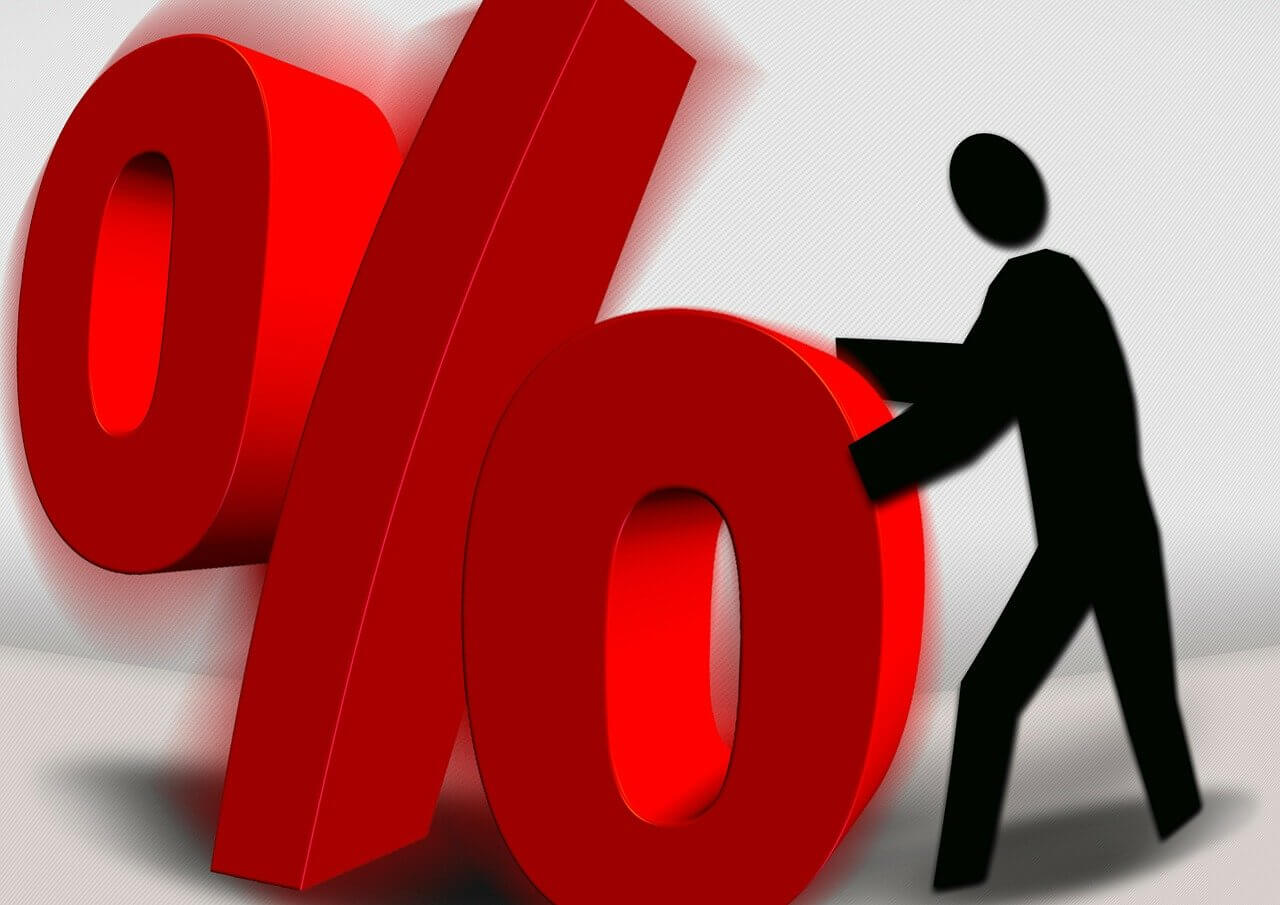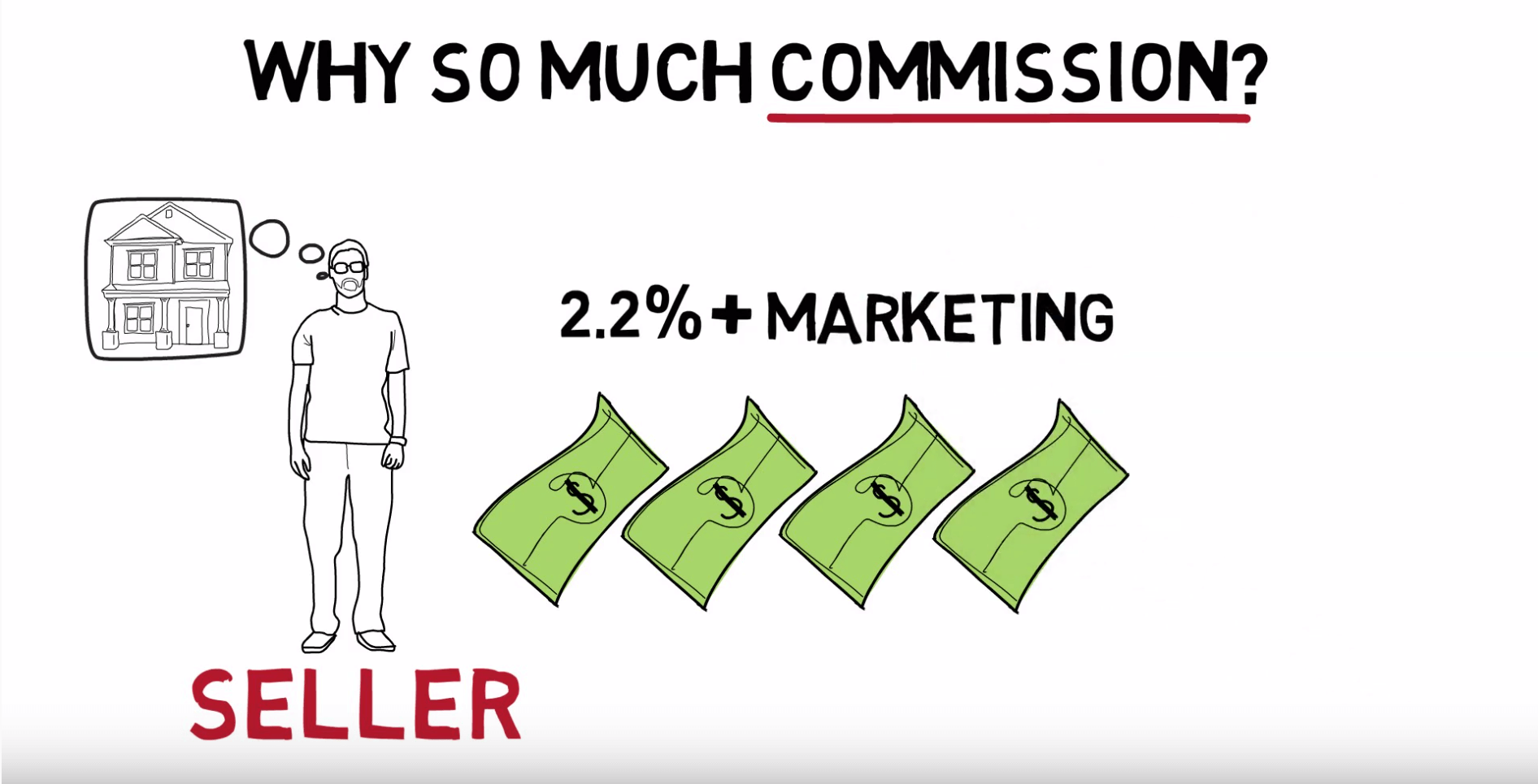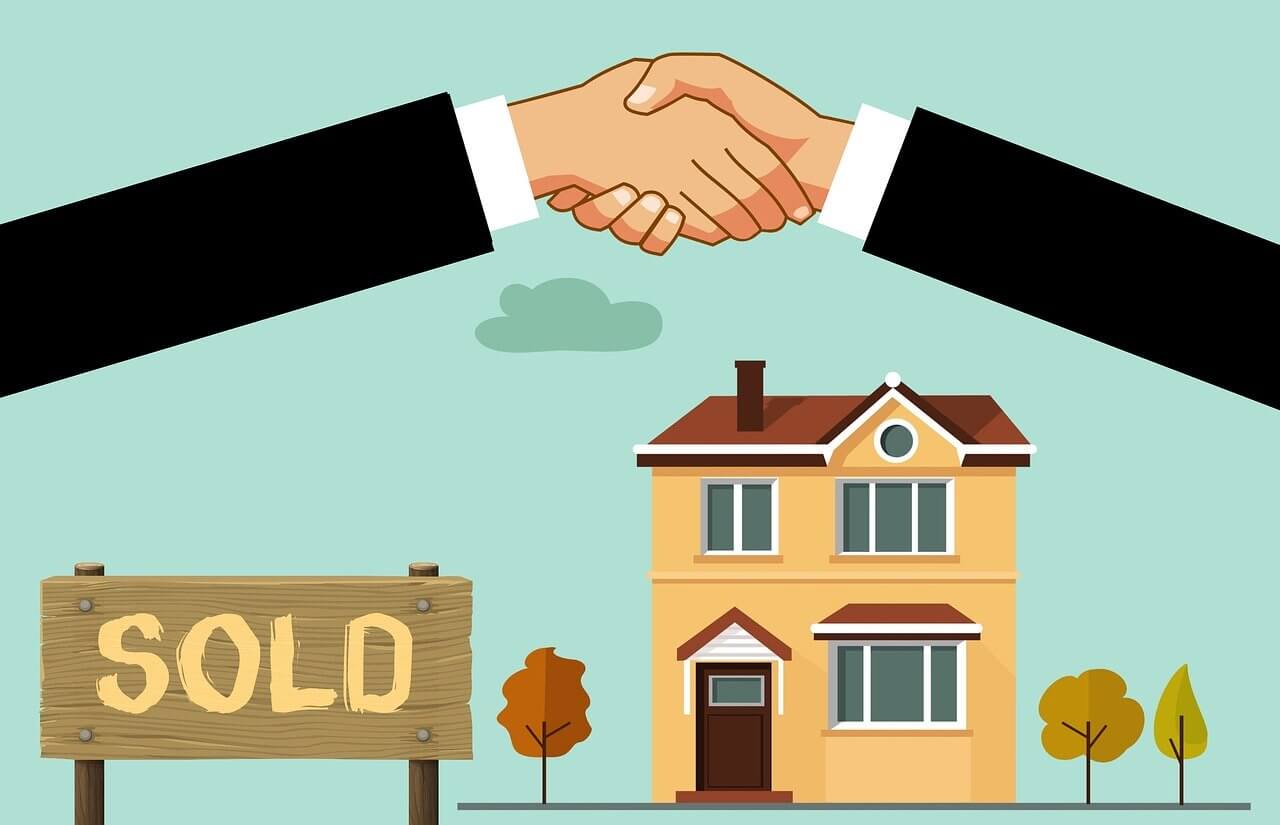NO PURPLE BRICKS: What we actually offer for only $9,999
How to make your property stand out online
Do Agents Still Need to be Local?
How much do estate agents charge to sell your home in Sydney?
There are many ways estate agents can charge to sell your home, however agent fees are being disrupted now more than ever before!
I guess it’s time to bring you up to date with what’s been happening!

Did you know that there are 3 main ways estate agents can charge you to sell your home? Most real estate agents don’t want you to know about the third option… but it’s your lucky day today, because I’m going to unpack it all for you!
“Thanks Joe! “
The Traditional Commission + Marketing approach

But before we get into that, let’s unpack the traditional way estate agents charge (as this is still the most common fee structure in real estate).
Traditionally, real estate agents in Sydney have charged a commission rate on the final sales price. The typical commission rate in Sydney will hover around 2.2% (including GST).
They charge marketing costs on top of their commission, which includes photos, video, online ads and other extras. So marketing costs will be on top of the commission amount.
Average commission rates change by Suburb!
According to the blog at Open Agent, the average commission in Glebe for example is 2.15%, whereas in Surry Hills it’s 1.97% and 1.95% in Woollahra.
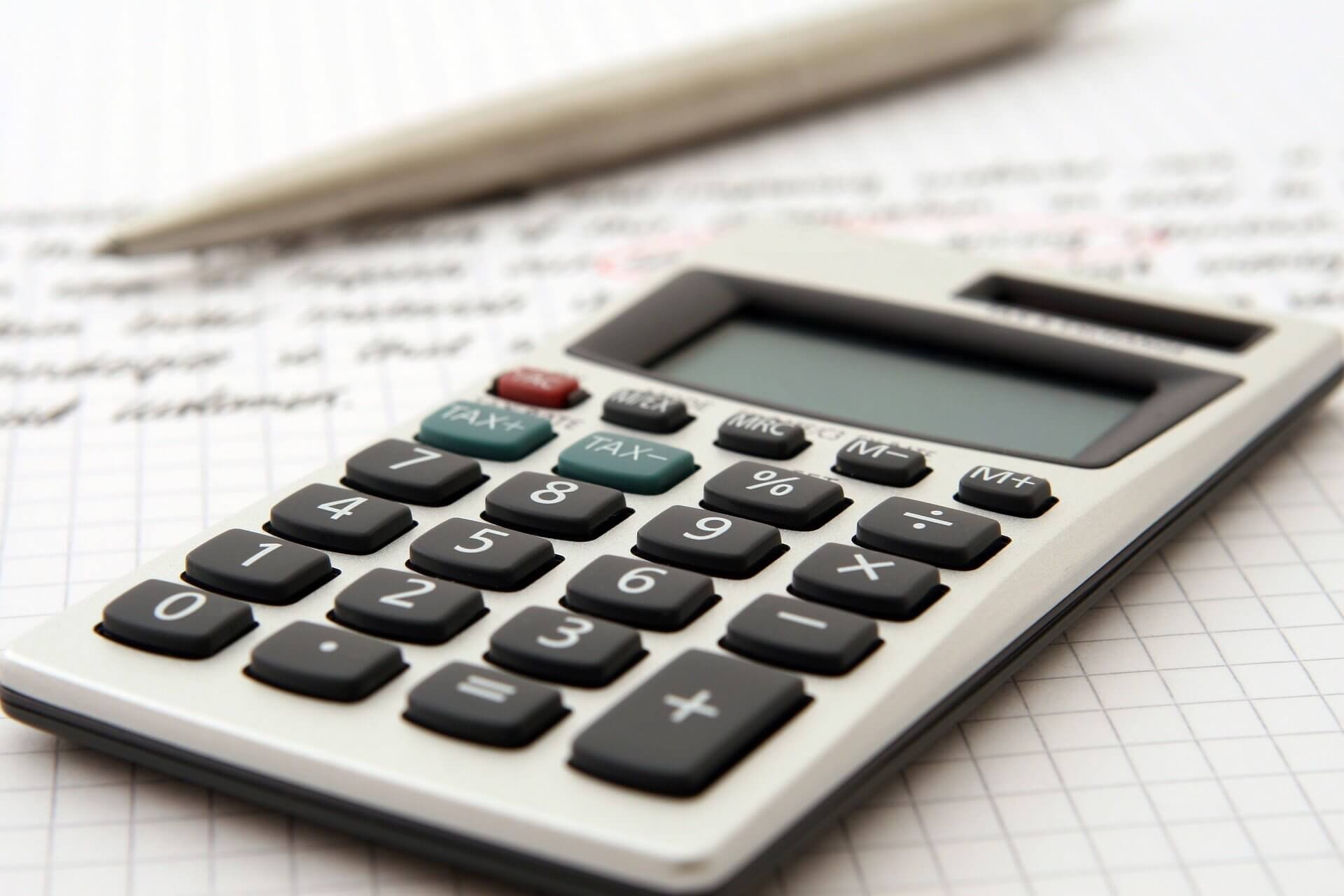
So the exact rate will change by area, and if you’d like to see what the average is for your area, you can use this search function or the calculator with Which Agent.
Comparing commissions to different states
This table from listing portal realestate.com.au suggests that across the country:
- Commission rates range from 1.5%-3.5%.
- Conveyancing ranges from $800-$2000
- Separate marketing charges typically range from $1,000-$10,000.
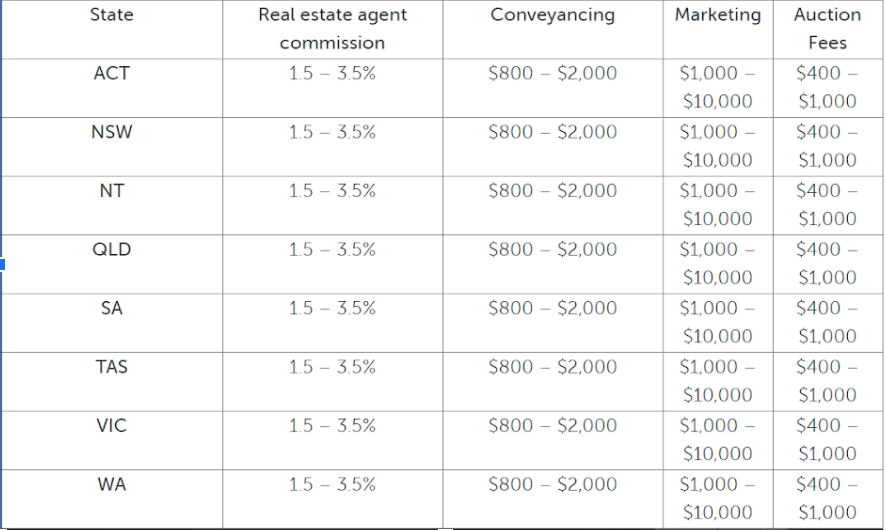
We should point out that there is a big difference between 1.5% and 3.5%! On a $1.5 million property, that’s $22,500 compared to $52,500! A difference of exactly $30,000…
Auctions
Auctions are perceived to be very expensive but this is a little bit of a myth in real estate – even in Sydney. My own father, who is a developer and has worked in property for almost 30 years thought auctions cost way more than private sales!
The table from REA above is actually pretty accurate as a guide: an auction only an costs up to $1,000 more than a private treaty campaign. This may be interesting for you as there are a lot of advantages to selling by auction if the market conditions are right.
It’s Not Regulated, and there are alternatives
We should point out that the way agents charge is not regulated, as you’ve seen from the range of commission rates. Now more than ever, there are different options to get a home sold.
Tiered Splits
Tiered splits are sometimes negotiated by sellers and agents. This is where the commission rate itself will actually change depending on the final sales price achieved.
For example, the base rate might be 2.2% if the agent achieves $1.5 million or lower. But this climbs to 3.5% for any amount above $1.5 million. The 3.5% applies to the difference between the higher and lower price.
For example, on a $1.7 million sale, the commission would be 2.2% of 1.5million + 3.5% of $200,000 (which is the difference between 1.7 million and 1.5 million).
This is $33,000 + $7,000, making a total tiered commission of $40,000.
This structure makes sense if you believe that a higher commission for the agent creates greater incentive and ability for them to achieve a higher price. Some in the industry find this controversial, suggesting that the agent shouldn’t need any more motivation to get a higher price.
I wonder what you think?
Low, fixed, flat fee model which includes marketing
On the complete other end of the spectrum is the fixed, flat fee model made famous by Purple Bricks.
A fee that is low, flat and fixed will be kept the same independent of the final sales price or area. It will include marketing rather than give you additional expenses to the selling fee. (Remember in Australia, the norm is to charge 2.2% commission and then add marketing costs on top of that).
So if the fee is fixed at $9,999 for example, then it doesn’t matter if the property sells for $600,000, $1.5 million or $15 million. All that will be charged to the seller is $9,999.
Purple Bricks…

Whilst Purple Bricks has been bashed in the media for ‘failing’ in Australia, the business made a large impact in the UK and USA.
Not only that, but following their entry into a poor property market in Australia in circa 2017, they are still estimated to have sold 7,700 properties in around 2 years. Not bad for a ‘failure’. This shows there is big demand for no-commission and low fee alternatives amongst Aussie sellers.
The Thinking behind low fee
The low, fixed fee structure supports the idea that commission doesn’t actually motivate an agent to get a better price. As Sydney Listings currently uses a low, flat, fixed fee, this is obviously what our agency believes at the moment.
 Obviously this debate will continue for some time but for now I want to make the following points:
Obviously this debate will continue for some time but for now I want to make the following points:
- Not all fixed-fee agencies are created equal. For example, there are very few similarities between Purple Bricks and Sydney Listings as you can see here if you need.
- We can measure these results. For example, on this sale in North Kellyville Andy Diaz achieved a ridiculous $1.41 million for a sale on a low fee model in 2019.
- I believe that commission will motivate some agents more than others. Some agents are motivated to get the price for the client and won’t be as concerned by commission as others.
Where did the commission model come from?
I think it’s always healthy to mount a challenge to the way we do things. How else do we make industries like real estate better and fairer over time? My process for testing whether something is still needed is to look back as to why it was created in the first place.

This agent select article suggests that the hot market in Sydney and its desperate buyers creates a certain demand. This demand puts agents in a position where they don’t feel downward pressure on their commission.
The reality is that the commission model was started at a time where real estate processes were more manual, and when property prices were lower. Thus, the fees had to be higher to make working as an agent feasible.
Since then, real estate agencies have been riding property price growth. Learn more about why agents charge so much commission here.
From our perspective, the commission charging business model is out of date and needs a refresh. It should not cost tens of thousands of dollars to sell a home anymore.
Why do Real Estate Agents in Sydney get paid so much Commission?
We hope you enjoyed learning why real estate agents in Sydney get paid so much commission!
Click here for more insights from Joe Wehbe and the team at Sydney Listings!
How much money can I keep when I sell my home?
“Joe, I know you can sell my house for big bucks, but how much of that is actually going to end up in my pocket? How much money can I keep when I sell my home?”
The real estate process can be a bit confusing. It is not the most transparent transaction, and that’s why our mob here at Sydney Listings wanted to unpack for you very clearly how much you get left with when you sell.
We’re going to talk about 5 big costs or factors that come out of that final sales price, and then you can go and easily run your own numbers to understand what you’re going to be left over with once you cash in!
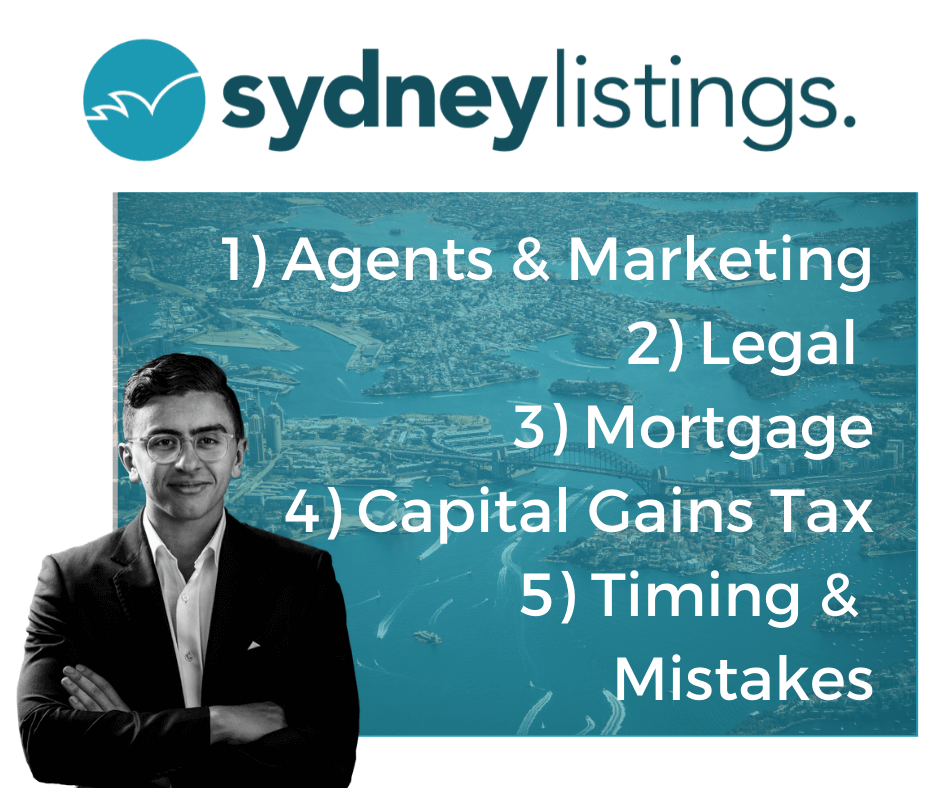
Agents & Marketing Costs
This is the big and obvious one. The real estate industry in Sydney is still dominated by a commission model.
So, an agent will charge on average 2% + GST of your final sale price. Some agents charge up to 3%.
So if you were selling a $1 million property the average agent’s fee would be $20,000 + GST.
BUT this is not the full picture because in Australia marketing expenses to the seller are charged separately to and on top of commission.
Marketing expenses include:
- Brochures
- Photography
- Signboards
- Video
- Advertising on listing portals like realestate.com.au and domain.com.au
- and more…
How much is this? Well in some areas it can be as low as $4-5,000, and in premium suburbs it can be up to $25-30,000.
Don’t have a heart attack just yet! Use an average range of $4-7,000 for now for a ‘run-of-the-mill’ property sale. So you’re looking at $27,000 in agent and marketing fees on a $1 million property.
There’s currently $973,000 sitting in your pocket if you use a traditional agent.
Reducing Selling Costs in order to keep more money when you sell your home
Now if you’ve seen our wacky “ARREST THE AGENT” campaigns you know that there are alternatives out there. Agents at Sydney Listings are currently able to sell homes for $9,999 in any area without compromising on service.
(Bloody impressive isn’t it).
Now obviously I recommend this but I’m not exactly impartial. There is innovation happening in real estate and there will be benefits passed on to customers as a result.
As always, whether you go with the old fee model or an updated one like ours you need to be comfortable that you’re getting a good service. If you need to know more about our solution, there’s details here.

But now let’s get back to your pocket. With a modern agent you could actually have $990,001 left in your pocket, rather than $973,000.
“Thanks Joe” you’re all saying.

Legal Costs
Often overlooked but in Australia legal professionals are an important part of the sales process.
To organise the property to be sold you will need conveyancing done – this is the legal work required in creating the contract, mortgage and other important documents for the sale.
In other words, all the BORING stuff so that us agents don’t have to do it!
If you’ll take another Sydney Listings tip, we recommend you always use a SOLICITOR who does conveyancing rather than just a stand-alone CONVEYANCER even though it is slightly more expensive.
The reason is that if there is legal trouble, the solicitor will be able to advise you and handle matters whereas the conveyancer will not.
Allow around $1,650 plus disbursements for a good conveyancer.
In your pocket at this point: $988,000 vs. $971,000 from that $1 million sales price.
Mortgage
Most of you will have a mortgage to pay out on your property and so you will need to clear any outstanding debt with the proceeds of the sale.
Your lender will get cross with you and put you in the naughty corner if they don’t get their money. So the lender ensures that they get paid first before you settle.
So if you have $600,000 of debt outstanding on your property sold for $1 million, you’ll have somewhere between $388,000 and $371,000 in cash left over.
Now this REA article paints a clear picture about implications with your mortgage. If the value of your property has gone down or is less than the outstanding debt, you may be in the dangerous region called negative equity.

For example, if the debt owing was $1.2 million, and you sold for $1 million… well you don’t need to be a mathematician (though if you’re not, you’re $200,000 short) to know the bank will not be happy.
In this instance, the lender will actually take steps to recover their debts before allowing the settlement to go through.
The other time a lender can get involved in holding up your settlement is if you’ve cross-collateralised two loans together. You don’t need to know about that right now as it’s getting complicated but if this affects you, you can learn more here.
Capital Gains Tax.
Capital Gains Tax is the tricky one out of this bunch. Most people will factor in the direct costs from the agent and the mortgage owing but neglect Capital Gains Tax (othewise known as CGT).
Whilst we refer to CGT you don’t actually pay it separately, you just pay it as part of your normal tax. That is, it is considered alongside the rest of your income. So keep that in mind, it is dependent on your overall position.
To help explain it for Australia I thought this was the clearest video online for you visual learners: although it uses a shares example.
The simplest and clearest blog article I believe for you is this one from HR Block !
Capital Gains Tax (CGT) applies more to investors than owner-occupiers.
You are actually exempt from CGT in Australia under the following conditions:
- The property was purchased before 1985 (as this is when the legislation was introduced)
- The property is your Principal Place of Residence, and not a pure investment property
We then get into another headache about whether a property qualifies as a principle place of residence or not. I was trying to help a friend figure out if they were exempt recently – you should see how much time and research they put into this rabbit hole!
Gee tax is fun!
It may not be necessary to open this whole essay here, but in short:
- There is not absolute clarity from the ATO on the criteria for a principal place of residence (PPR for short)
- You can only have one PPR, unless you sell and start the process again.
- There are extra implications if you have lived overseas in this time … see here
- Just because a property collects rent doesn’t mean it can’t qualify as your PPR, as long as you lived in it for a period (although this period is somewhat vague)
- The HR Block Blog suggests you can still claim exemption for a property if you relocate due to medical or disability reasons to a care facility instead of living there.
- CGT is higher if the asset is sold within 1 year.
How do I figure out what my CGT amount is?
The obvious answer to this question “How do I figure out what my CGT amount is?” would be to “ask your accountant”.
BUT if interested, Michael Yardeny from Property Update outlines three methods and they are based on timing and circumstances of the sale.
There are also calculators you can use online to get a rough indication of CGT but remember that this is not as precise as using an accountant.
Using this calculator, an example of a property bought for $875,000 which is sold 2 years later for $1 million, by an investor earning a $90,000 a year salary with no other income would be approximately $24,375. But if sold within 12 months, the CGT payable is estimated to be more than double at $51,550.
Big difference there of $27,175.
Say we’re using the 2 year example, there’s now either $363,700 or $346,700 remaining, again depending on that agent choice.
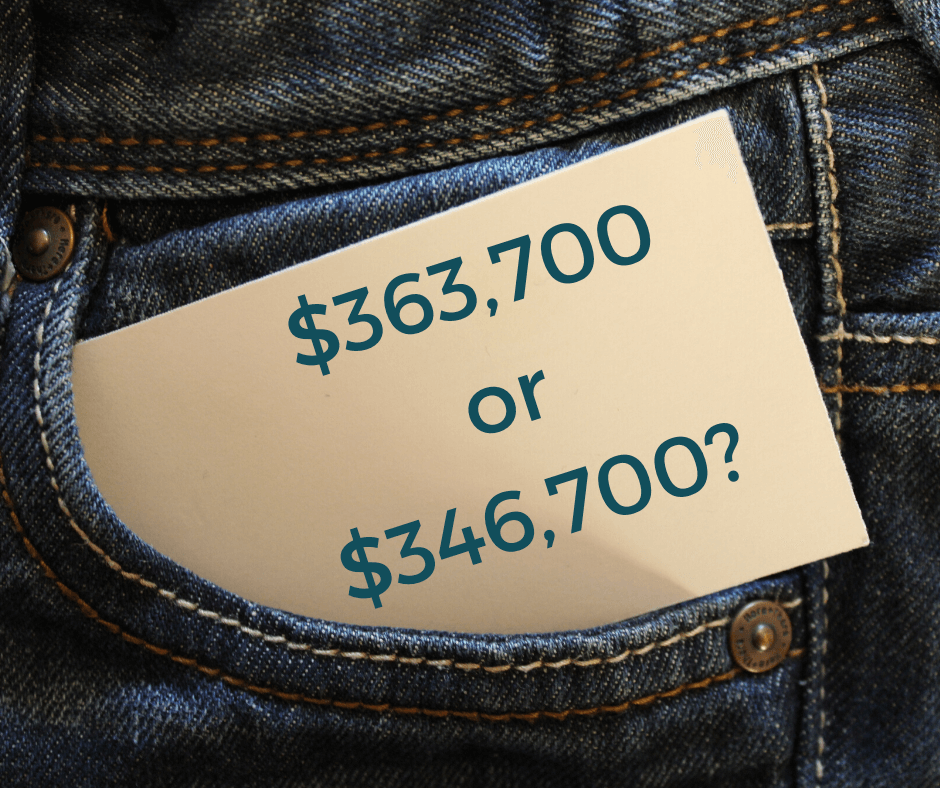
The total non-mortgage costs of exiting the property so far are $36,000 vs. $52,950 for the example we used. Just note that these will constantly change based on the situation!
Timing and Mistakes
Don’t forget that the market value changes over time, going up and down and may be different from when you start looking to sell from when you eventually get on the market.
Don’t be surprised if the scenario is very different within 4-6 months! Which is why you should regularly appraise the property with agents as well as through self-education ever 6 months when you’re thinking of selling.
If you need more advice on how to time the right point sell, go here.
Also, using the wrong professionals, be they accountants, agents, solicitors or mortgage brokers can cost you more. Being strategic about the sale and getting the right professionals around you can help you maximise how much money you keep when selling.
What will the cost be if your loans are set up incorrectly and your lender won’t release the security?
What will the cost be if your accountant cannot claim exemptions from CGT?
What will the cost be if there is a mistake in your contract of sale?
Could the wrong agent cost you up to $80,000 just because they’re not a skilled negotiator?
Good Luck and don’t forget to share this article with people who might find it useful!
Why do agents get paid so much commission?
So why do agents get paid so much commission?
It’s a question sellers have been asking for some time now. Regardless of whether you’re in Europe, the USA or Australia and we’re going to expose the biggest reasons for this model right now.
Commission was the best available fee structure for selling a home under the previous era of ‘traditional real estate’. But technology and the digital age mean that this is no longer the best structure available.
Why do agents get paid so much commission?
So here are FIVE reasons why.
1) Expensive, inefficient and complicated businesses
Traditional real estate businesses were set up in local franchises. They normally had a retail shop-front in every suburb, with a franchisee running the office.
Each office had its own rent and receptionist. These were times when local agents had more knowledge on the market, and it was hard to know what was available for sale or what a home was worth without an agent.

To service demand, agents in the office would go out and list properties for sale, and then get paid commission for a successful sale. In Australia this hovers around 2.2%-3.3% of the property’s sale price.
In the USA there is a different model in place where commission can be up to 6% but marketing is included, not charged separately.
But out of that fee a large portion would get paid to the franchisee, who then had to pay his admin staff, his rent, other expenses and marketing costs. Finally he had to pay the franchisor or ‘head office’.
Before the digital revolution, there wasn’t a more efficient way, so this was the best agencies could afford to charge. But as we’ll show beyond doubt, this has all changed.
Sellers do not benefit from having an agent with too many overheads, rents, admin staff and franchise fees to pay. So this is no longer a justification to be paying commission.
2) Agents waste their time
If you want a window into traditional real estate culture tune into a real estate seminar. 95% of what real estate trainers teach is how to ‘win more listings’.
Real estate is overly competitive and as a result agents focus on one thing… ‘Listing’ properties for sale. No effort goes into customer service and getting better at selling for clients.
There is almost no effort in training put into showing agents how to get more eyeballs on a property or achieve higher sales prices.
Especially in Australia.
Agents waste their time being too similar to each other, which focuses their attention on competing against each other rather than serving clients and chasing buyers.

Agents only have so much time in a day, yet they are encouraged to spend 3 hours everyday ‘prospecting’ for new ‘leads’ to convert into listings.
Then they have to book in appointments to give presentations… so there goes another 1-3 hours. If up to 6 hours is spent ‘prospecting’ then where is the time to convert those listings into actual sales?
The truth is agents need to charge the commission they do given the low amount of properties they can sell a year by using their time in this ineffective way.
3) Agents have their time wasted
The traditional agent is not all to blame. In truth they are hardly to blame at all, because they go into an outdated industry that does not set them up to succeed.
Whilst real estate looks simple from the outside, there are hard-working agents who simply have their time wasted. How you ask? Let’s start with who they have to communicate with:
- Sellers and Vendors: A good agent will have several of these to liase with at one time, and provide updates several times a week
- Multiple prospective buyers for each listed property: chasing calls that don’t answer first time, email enquiries, and scheduling inspections, following them up for feedback
- Related parties to facilitate and close a deal: From photographers, signboard companies and admin staff to mortgage brokers, solicitors and accountants
- Other members of their own team
Then on top of all this they will have to facilitate:
- Countless listing presentations that choose another agent and waste 1-2 hours of meeting time and likely hours of preparation
- Building & pest inspections as well as other inspections for the property that prove trivial
- Driving around contracts and paperwork to be signed by multiple parties
- Chasing up payments
4) Lack of technological uptake
The Franchise business model was the best for its time but its structure was not set up to update over time. This is one of the biggest reasons why agents get paid so much commission.
Each big brand office in your area is essentially a separate business run by a franchisee. As such it is hard to roll-out changes that every office in a network will agree with.
It also means that these fragmented offices are unwilling to come together to centralise their overheads and cut down the extra expenses.
FACT: Technology and social media can help agents get more eyeballs on property campaigns in this era and sell properties faster.
FACT: Technology can cut out time spent on most manual processes described above, and this will only improve over time as the buying and selling process becomes more digital and online.
Yet real estate agents are not traditionally required to have digital skills. This is why they have become so vulnerable, along with their commission-based structure for payment.
5) Traditional Agents who cut fees under-performed
Traditional real estate agents who lowered their commission to get listings did not perform well. It’s clear to see why from the above.
By lowering fee but not making any structural changes to the manual processes, time wasted and business set-ups, all agents did was cut margins.

Whilst that gets a few more listings, it does not streamline things and merely creates more work for the desperate agent. That’s why the cut-fee approach is not a good one for sellers.
If it was, we would have seen a steady decline in commission rates over time internationally. But we haven’t. Instead, established agents are still able to charge high commissions.
Digital Real Estate
So that will likely answer the question “why do agents get paid so much commission?”. Rather than the expert knowledge agents have or their work ethic, the reasons are largely structural.
That’s why structural changes in a digital real estate model are the solution to lowering the fee required to do a good job. There is no point saving $15,000 on fees when the property sells for $50,000 less.
The digital age of real estate instead works to streamline the entire process. It works to get that high sales price. But by cutting out the time, waste and expenses, it passes on more savings.
Can you use video to advertise properties for rent?
One question few agents ask is whether you can use videos to advertise properties for rent?
So much attention goes into selling property. But there are improvements we can make to the way we advertise properties for rent.
Why is video advertising for rental properties rare?
1) Cost
Property marketing videos are traditionally not cheap and hurt your pocket. Normally they will cost in excess of $2,000… so this is rarely worthwhile for a rental property.

The difference we make in our agency is that we have in-house videography solutions. This makes video cheaper and easier for landlords to access as an option, making their property stand out against the competition.
2) Agents who are not bothered
One of the most common jokes in real estate: “Property Managers are agents who can’t make it in sales”. The stereotype for agents working in rentals is that they are less ambitious and talented.
There is less incentive for innovation and creativity. Property Managers normally have less property marketing skills than sales counterparts, and they will not think to make videos for rental properties.
3) There is a shortage of true marketers in the industry
In our business for example, we consider ourselves marketers who happen to be working in property.
A marketer is someone who understands their customer, and then designs advertising that is most likely to attract and convert the target customer.
Most real estate agents make their living by simply uploading properties on the internet. They are not strategic and don’t adapt over time to changes in customer behaviour.
You can absolutely use a property video to advertise your property for rent
Check out our example below which shows an in-house ad for Asquith. Filmed and edited to highlight unique features and short enough to capture attention.
The benefits of video advertising in real estate are…
Want to understand the benefits of using a video to advertise your property? You should check out our article is a property video worth the money?
In it we discuss how video consumption is on the rise. Customers prefer video and it plays a major role in their decisions. So, we recommend taking advantage of video when selling OR renting your property.
How to market your property when selling your home
How do you market your property when selling in our digital era? The traditional sales and marketing process in real estate has evolved dramatically. Instead of relying on local agents and shop windows, we now have major listing portals like realestate.com.au and domain.com.au in Australia.
Why is marketing your property important?
Marketing is an investment in yourself. It’s not a cost or reliability so you need to maximize the exposure, catching all the potential buyers for your marketplace.
The more you spend on marketing, the greater the chance of finding that perfect buyer who will pay a premium price.
Buyer Competition
Marketing should be there to create buyer competition, so that multiple offers come in and you can work with those offers to secure the very best price for your property. This principle has always been important in real estate, and sales in general.
Modern Real Estate Agents and Marketing
Few agents in this day and age demonstrate an understanding of modern marketing. We see so many agents only list properties on two major portals. This is because it is all they know how to do, apart from offering print advertising.

Social Media, Digital Marketing and the rise of Video have been more recent developments, and most agents are finding it difficult to fully take advantage of these mediums.
For instance, many agents will not understand how to use Facebook and Instagram differently to realestate.com.au and domain.com.au. This comes into the difference between warm and cold traffic.
Warm and Cold Traffic
Let’s use the example of realestate.com.au vs. Facebook to market your property when selling.
When people go onto realestate.com.au, they are hot traffic. They are looking to learn more about prices, see what is on the market, and check out options to buy.

People don’t go into Facebook to make purchasing decisions. They are more of a cold audience. They are on there to make a post, check notifications, see photos of people. We advertise to people on Facebook by creating content that they are looking for here, and then distract them.
So these ads are designed differently to have full effect. Mediums like Facebook, Instagram and Youtube can also be very targeted. They can target people based on area, and interest.
The crazy world of targeting, re-targeting, look-alike audiences and cost per impression is far and beyond traditional agents. The same can be said for real estate property videos. The industry’s future is going to be extremely digital and geared towards a new generation who understand these platforms.
Feel free to hang out with us on social media or subscribe for more tips and insights!


